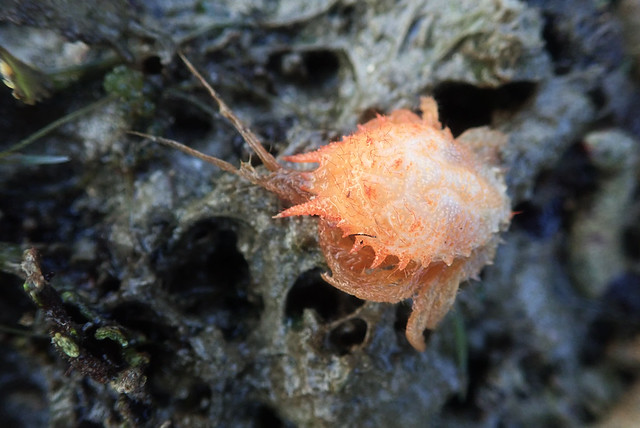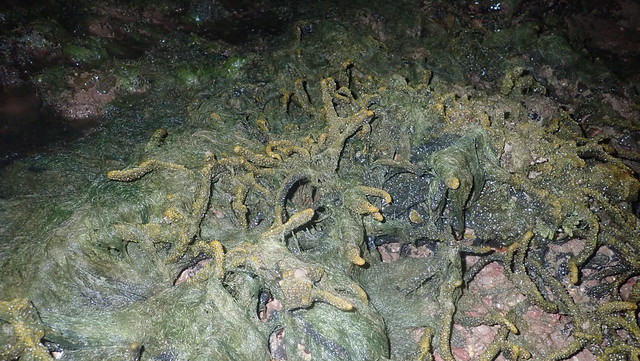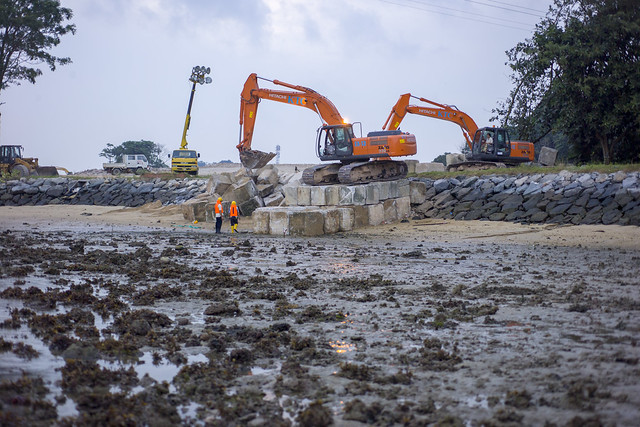There were dense patches of branching corals at Sentosa this morning! Some of the seagrasses are doing well and I saw some interesting creatures.
It is always bitter sweet for me to survey this shore. I had helplessly watched some of the reefiest parts of the northern shoreline being buried for Resorts World Sentosa 10 years ago.
After the reclamation for Resorts World, this part of Sentosa never really had many hard corals. But there are a few large ones still there. Like this one opposite Labrador Nature Reserve with the lights of the Pasir Panjang Container Terminal on the horizon. I did the southern shoreline quickly as I didn't want to get hurt in the dark, and arrived on the northern shoreline at first light.
Some special corals seen include one Lettuce coral, a few Disk corals, many Sandpaper corals and one Cauliflower coral. None of them were bleaching and most of the colonies were well formed.
The most abundant corals were Merulinid corals and Boulder pore corals, including some Branching pore coral. At night, coral polyps are out and are sometimes brightly coloured. None of those I saw were bleaching.
There was one huge Omelette leathery soft coral, but also a few small colonies elsewhere. There were many blue Broad feathery soft corals and some corallimorphs.
There were a lot of Giant carpet anemones along the northern shoreline. I saw about 10, but none had anemonefishes. I saw a few Frilly sea anemones and some patches of Button zoanthids.
A survey in the dark means a more lively shore as animals are more active. I saw one Octopus hunting in the dark!
Usually found out of water on the rocky shore, I saw one Ferocious reef crab hunting in the water among the seagrasses.
Another special find was the fresh moult of a Masked burrowing crab, listed as Vulnerable on the Red List of threatened animals of Singapore. We've seen these crabs on Sentosa before, I hope this means they are still here.
There were many swimming crabs out and about among the seagrasses in the dark. Also some Purple climber crabs on the rocks, and on the sandy areas some Sand bubbler crabs.
It was great to see a Heart cockle, and the token nudi sighting - the Cheesecake nudi. There were also a few moon snails and even live Gong gong snails. At the sandy patches among the rocks, I saw about 10 Cake sand dollars.
The Heart cockle had attached itself to some small stones with byssus threads coming out of the gap between its two-part shell. The two-part shell is thin and heart-shaped with the opening of the valves down the centre of the 'heart'. One half of the valve is flat while the other is convex. Unlike most other bivalves, the heart cockle harbours symbiotic zooxanthellae (a kind of single-celled algae) in its body. The zooxanthellae produce food through photosynthesis which it shares with the clam. To maximise the productivity of its "farm", the flat side of its shell is translucent and the animal faces this side towards the sunlight.
There were also sponges of various kinds on the shore. The most abundant being Silvery blue sponges, some covered rather large patches.
It was nice to see many clumps of Tape seagrasses with long leaves on the shore near Resorts World. They extended from deeper waters to the low water mark. Sentosa appears to be among the last stronghold of long leaved Tape seagrasses as the blades of these seagrasses are cropped almost everywhere else in the south.
But I only saw one female flower and one male flower (bloomed already) and there were many clumps of Tape seagrass with cropped leaves.
Spoon seagrass was everywhere. On the northern shoreline, there are still some small patches of Sickle seagrass and sprinkles of Needle seagrass.
There is still a suffocating bloom of Bryopsis over the southern shoreline. The seaweed grows everywhere, smothering sponges and other animals. My last survey here was in Jan 2018 in the daytime. So it's a little hard to make a close comparison.
It is always bitter sweet for me to survey this shore. I had helplessly watched some of the reefiest parts of the northern shoreline being buried for Resorts World Sentosa 10 years ago. I took this photo in 2007.
Massive construction on the shore in 2008.
Ongoing construction of Resorts World in 2009
Here's a patch of corals today, in front of where Underwater World used to be, now just a field of grass.
How ironic that our priceless reefs are buried to create artificial marine habitats that profess to support marine conservation. And when they fail, will they even attempt restore the reef back to the way it was before?





















